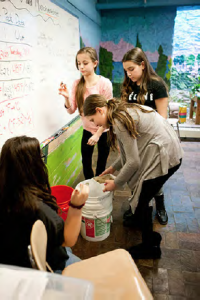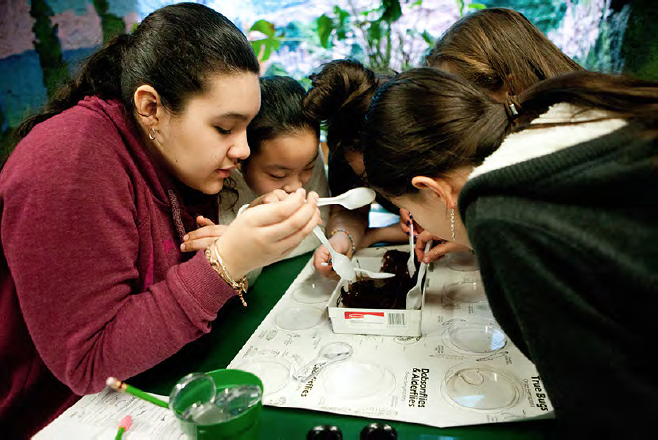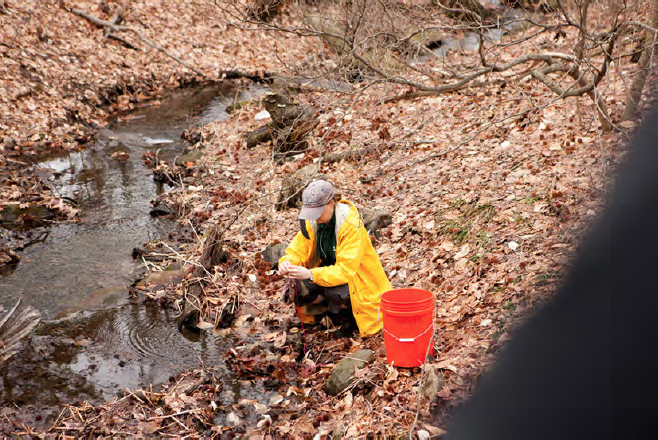Citizen Science: Emerging Macroinvertebrates
Posted in Children's Education, Learning Experiences on June 25 2015, by Madeline Breda
Madeline Breda is a GreenSchool Science Education Intern at The New York Botanical Garden.

In early March, I posted a primer on the Garden’s Citizen Science program, focusing on the biotic water quality testing workshops offered to visiting students at NYBG’s own GreenSchool. Presented in partnership with the New York City Department of Education STEM Matters, Citizen Science workshops aim to educate children from all five boroughs about ongoing, “crowd-sourced” scientific research that is accessible to amateur scientists and laymen alike.
Over the course of the month of March, I had the pleasure of working with the students of P.S. / I.S. 87 Middle Village as they sorted leaf packs, bravely handled and identified macroinvertebrates, and ventured into the Thain Family Forest in order to perform site surveys. Under the guidance of science teacher Ms. Vivian Alforque, sixth, seventh, and eighth graders were all given the chance to participate in meaningful scientific research on the grounds of our historic institution.
Now, on to what I’m sure you’ve all been wondering: which macroinvertebrates did we find?
(As a reminder, macroinvertebrates can be defined as “large” (>0.2 mm) animals lacking backbones. The macroinvertebrates we study are technically benthic freshwater macroinvertebrates—they inhabit low-lying areas within bodies of fresh water, such as streams, rivers, and ponds. These critters flock to naturally-forming and man-made leaf packs alike: assemblages of waterlogged, decomposing leaves serve as excellent habitats for diminutive insect larvae, crustaceans, and more.)

At the time of my last posting, the ground of the Thain Family Forest was blanketed thickly with snow, and conditions looked tough for our leaf pack-dwelling invertebrate friends. By the arrival of our first group from P.S. / I.S. 87, however, snow had started to thaw with a vengeance, adding snowmelt runoff to the volume of water flowing down tributary streams and into the Bronx River. The waterways were turbulent, looking like fairly inhospitable places for insects and other small creatures to dwell.
After transporting leaf packs from the stream back to the classroom, however, it became clear that the macroinvertebrate life cycle was continuing on happily, uninterrupted by the early spring runoff. Amongst many varied taxa, three were the most prevalent:
- • Larvae of the Chironomidae family (common name: midges)
- • Isopods (common name: aquatic sowbugs)
- • Amphipoda (common names: freshwater shrimp, scuds, sideswimmers)
The above three macroinvertebrate taxa serve as excellent indicator organisms: that is, the presence, absence, and amounts of various species of these organisms within a body of water can indicate whether pollutants are present. All macroinvertebrates noted within the Stroud Leaf Pack Network have been assigned a “pollution tolerance indicator,” a number between 1 and 10, in which a low number corresponds with low “pollution tolerance” and a high number corresponds with high “pollution tolerance.” For example, stonefly nymphs (members of the order Plecoptera) have a low pollution tolerance value (1 out of 10) because they respire through their skin—porous skin allows toxic environmental pollutants easy access to the organism’s vulnerable internal organs. Consequently, a polluted body of water would not support many stoneflies whilst “hardier” macroinvertebrates would flourish and dominate the leaf pack population.
The macroinvertebrates we found in March—chironomidae, isopods, and amphipoda—have all been given relatively high pollution tolerance values of 6, 8, and 6, respectively. Therefore, encountering a leaf pack community dominated by these taxa is troubling.
Though it is not wise (or statistically logical) to make any rash assumptions based upon results from one data set, the experience of participating in citizen science encouraged students to think deeply about the interconnectedness of our natural world—even in the heart of the Bronx. Students were asked to consider which environmental factors may have contributed to the (astronomical) pollution levels suggested by their leaf pack data, while noting weather patterns and the time of year, which may have also had some effect on leaf pack results.

Thus, the utility of the citizen science class is not for students to arrive at any one “discovery” (that is the job for statisticians and scientists who analyze years of crowd-sourced citizen science data), but instead to get students thinking critically about the many factors affecting good scientific research. Students experience the messiness of field research first-hand, which, after much hard work and deliberation, can be transformed into clean, meaningful data. Through the process of acting and thinking like scientists during citizen science workshops, students effectively become scientists. How cool is that?


I think you have the tolerance numbers
reversed. A low number indicates low
tolerance for pollution.